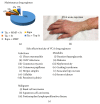Emerging Implications for Extracellular Matrix-Based Technologies in Vascularized Composite Allotransplantation
- PMID: 26839554
- PMCID: PMC4709778
- DOI: 10.1155/2016/1541823
Emerging Implications for Extracellular Matrix-Based Technologies in Vascularized Composite Allotransplantation
Abstract
Despite recent progress in vascularized composite allotransplantation (VCA), limitations including complex, high dose immunosuppression regimens, lifelong risk of toxicity from immunosuppressants, acute and most critically chronic graft rejection, and suboptimal nerve regeneration remain particularly challenging obstacles restricting clinical progress. When properly configured, customized, and implemented, biomaterials derived from the extracellular matrix (ECM) retain bioactive molecules and immunomodulatory properties that can promote stem cell migration, proliferation and differentiation, and constructive functional tissue remodeling. The present paper reviews the emerging implications of ECM-based technologies in VCA, including local immunomodulation, tissue repair, nerve regeneration, minimally invasive graft targeted drug delivery, stem cell transplantation, and other donor graft manipulation.
Figures





Similar articles
-
Perfusion decellularization for vascularized composite allotransplantation.SAGE Open Med. 2022 Sep 13;10:20503121221123893. doi: 10.1177/20503121221123893. eCollection 2022. SAGE Open Med. 2022. PMID: 36120388 Free PMC article. Review.
-
Vascularized composite allotransplantation: current standards and novel approaches to prevent acute rejection and chronic allograft deterioration.Transpl Int. 2016 Jun;29(6):655-62. doi: 10.1111/tri.12652. Epub 2015 Sep 14. Transpl Int. 2016. PMID: 26265179 Free PMC article. Review.
-
Vascularized composite allografts and solid organ transplants: similarities and differences.Curr Opin Organ Transplant. 2013 Dec;18(6):640-4. doi: 10.1097/MOT.0000000000000019. Curr Opin Organ Transplant. 2013. PMID: 24126807 Review.
-
Vascularized composite allotransplantation: towards tolerance and the importance of skin-specific immunobiology.Curr Opin Organ Transplant. 2013 Dec;18(6):645-51. doi: 10.1097/MOT.0000000000000022. Curr Opin Organ Transplant. 2013. PMID: 24126805 Review.
-
Premise and promise of mesenchymal stem cell-based therapies in clinical vascularized composite allotransplantation.Curr Opin Organ Transplant. 2015 Dec;20(6):608-14. doi: 10.1097/MOT.0000000000000247. Curr Opin Organ Transplant. 2015. PMID: 26536421 Review.
Cited by
-
Perfusion decellularization for vascularized composite allotransplantation.SAGE Open Med. 2022 Sep 13;10:20503121221123893. doi: 10.1177/20503121221123893. eCollection 2022. SAGE Open Med. 2022. PMID: 36120388 Free PMC article. Review.
-
Recellularization of Bioengineered Scaffolds for Vascular Composite Allotransplantation.Front Surg. 2022 May 25;9:843677. doi: 10.3389/fsurg.2022.843677. eCollection 2022. Front Surg. 2022. PMID: 35693318 Free PMC article. Review.
References
-
- Swanson J. W., Johnston J. L., Mitchell B. T., Alcorn K., Taylor J. A. Perioperative complications in posterior pharyngeal flap surgery: review of the national surgical quality improvement program pediatric (Nsqip-Peds) database. The Cleft Palate-Craniofacial Journal. 2015 doi: 10.1597/15-154. - DOI - PubMed
Publication types
LinkOut - more resources
Full Text Sources
Other Literature Sources

